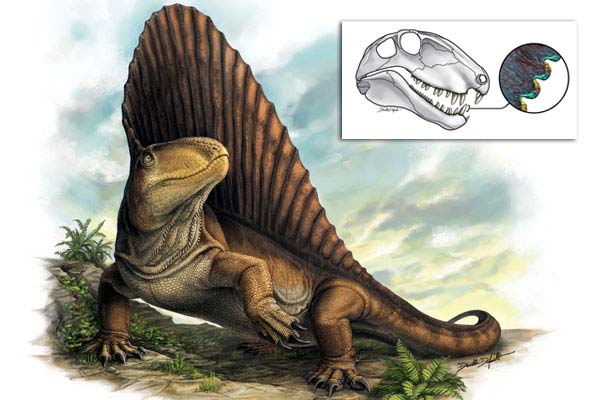
Dimetrodon had "steak knife" teeth, researchers say
Published: February 7, 2014
The first top predators to walk on land were not afraid to bite off more than they could chew, a University of Toronto Mississauga study has found.
Graduate student Kirstin Brink, lead author of the study, and Professor Robert Reisz from U of T Mississauga’s Department of Biology, suggest that Dimetrodon, a carnivore that walked on land between 298 million and 272 million years ago, was the first terrestrial vertebrate to develop serrated ziphodont teeth.
According to the study published in Nature Communications, ziphodont teeth, with their serrated edges, produced a more efficient bite and would have allowed Dimetrodon to eat prey much larger than itself.
While most meat-eating dinosaurs possessed ziphodont teeth, fossil evidence suggests serrated teeth first evolved in Dimetrodon some 40 million years earlier than theropod dinosaurs.
 “Technologies such as scanning electron microscope (SEM) and histology allowed us to examine these teeth in detail to reveal previously unknown patterns in the evolutionary history of Dimetrodon,” said Brink (pictured at right with Reisz and a Dimetrodon skull fossil).
“Technologies such as scanning electron microscope (SEM) and histology allowed us to examine these teeth in detail to reveal previously unknown patterns in the evolutionary history of Dimetrodon,” said Brink (pictured at right with Reisz and a Dimetrodon skull fossil).
The four-meter-long Dimetrodon was the top of the terrestrial food chain in the Early Permian Period and is considered to be the forerunner of mammals.
Brink and Reisz’s research found Dimetrodon had a diversity of previously unknown tooth structures and was also the first terrestrial vertebrate to develop cusps – teeth with raised points on the crown, which are dominant in mammals.The study also suggests ziphodont teeth were confined to later species of Dimetrodon, indicating a gradual change in feeding habits.
“This research is an important step in reconstructing the structure of ancient complex communities,” Reisz said. "Teeth tell us a lot more about the ecology of animals than just looking at the skeleton. We already know from fossil evidence which animals existed at that time but now with this type of research we are starting to piece together how the members of these communities interacted.”
Brink and Reisz studied the changes in Dimetrodon teeth across 25 million years of evolution.
The analysis indicated the changes in tooth structure occurred in the absence of any significant evolution in skull morphology. This, Brink and Reisz suggest, indicates a change in feeding style and trophic interactions.
"The steak-knife configuration of these teeth and the architecture of the skull suggest Dimetrodon was able to grab and rip and dismember large prey,” Reisz said. “Teeth fossils have attracted a lot of attention in dinosaurs but much less is known about the animals that lived during this first chapter in terrestrial evolution.”
The study was funded by a Natural Sciences and Engineering Research Council (NSERC) postgraduate scholarship to Brink and an NSERC Discovery Grant to Reisz.
Gareth Trickey is a writer with the University of Toronto Mississauga.



